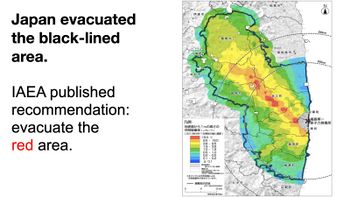Fear of radiation: Difference between revisions
imported>David MacQuigg No edit summary |
imported>David MacQuigg |
||
| Line 13: | Line 13: | ||
=Further Reading= | =Further Reading= | ||
Section 6 in [https://electrifyingourworld.com ElectrifyingOurWorld.com] by Robert Hargraves has a much more thorough discussion of radiation | Section 6 in [https://electrifyingourworld.com ElectrifyingOurWorld.com] by Robert Hargraves has a much more thorough discussion of radiation fear and its impact on public policy. | ||
=Notes and References= | =Notes and References= | ||
{{Reflist|2}} | {{Reflist|2}} | ||
Revision as of 11:10, 22 November 2021
- See also: Nuclear_power_reconsidered
Government agencies have for decades assumed that deaths and other bad effects of radiation on our health follow a theory called Linear No Threshold (LNT) in which death and disease is simply proportional to the total cumulative radiation, no matter how low the rate, even as low as the normal background radiation from space and the materials around us. This assumption ignores the data on low-rate exposures (Figs.1&2) and the fact that there are mechanisms in our bodies that repair damage done at a low rate (Fig.3).
Over reliance on the LNT theory leads to policies that are very costly, like radon remediation in old homes (Fig.4)
and over-reaction to radiation accidents, like the evacuation after Fukushima, which caused far more deaths that the accident itself (Fig.5).
LNT theory has also had a devastating effect on nuclear power. It has lead to the belief that an accident causing a small increase in radiation over a very large area could lead to a large number of cancers and deaths. A more realistic assessment will show that the danger from nuclear power is much smaller than the public believes, and much smaller that the risks from ever-increasing CO2 in our atmosphere.
Further Reading
Section 6 in ElectrifyingOurWorld.com by Robert Hargraves has a much more thorough discussion of radiation fear and its impact on public policy.




